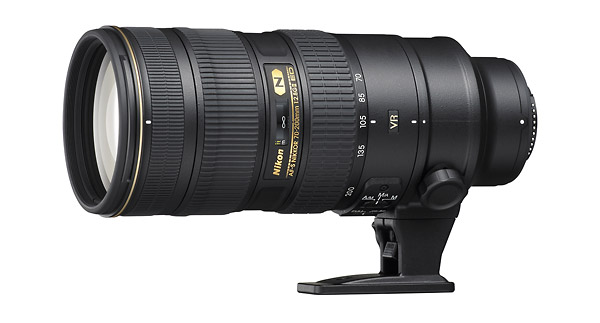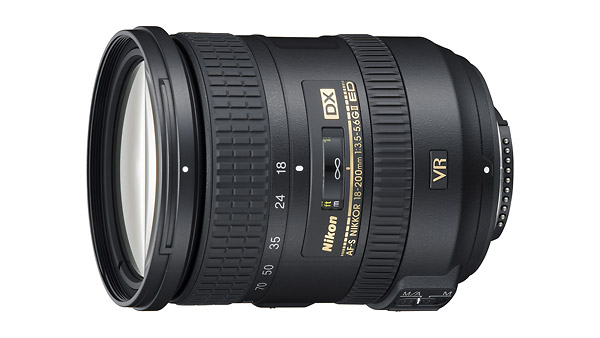
Along with the new D300s and D3000 digital SLRs, Nikon is introducing updated versions of two of their most popular lenses, the 18-200mm VR and 70-200mm VR. The AF-S DX NIKKOR 18-200mm f/3.5-5.6 ED VR II and AF-S NIKKOR 70-200mm f/2.8G ED VR II zoom lenses both feature Nikon’s most recent Vibration Reduction II optical image stabilization system. The new 70-200mm f/2.8G ED VR II Nikkor also has significant optical improvements.
The 70-200mm f/2.8 lens is the workhorse lens for many professional photographers. I haven’t used the 70-200 f/2.8 VR Nikkor lens. But from what I’ve heard it has some edge softness issues on FX-format (full frame) camera bodies. The hope and expectation among Nikon users is that the new lens will have better image quality with full frame digital SLR bodies like the D700, D3 and D3x. The main differences between the new lens and the old lens are the new VR II image stabilization system, new optical formula and improved lens coatings. The new lens adds two more ED elements for a total of 7. The new Nano Crystal Coat coating is supposed to further reduce lens flare and ghosting. This will make a difference for outdoor and sports photographers who don’t always get to work in optimal lighting conditions. The new VR II image stabilization is supposed to make it possible to shoot up to four stops slower and still get sharp photos. The VR II also offers two image stabilization modes. The “Normal” mode is for normal shooting and panning. The “Active” mode is intended to compensate for camera shake when there’s more motion. The press release uses shooting from a car as an example. Aerial photographers shooting from a plane or helicopter would benefit as well. If you’ve got more examples, please share them with us in the comments below.

The AF-S DX NIKKOR 18-200mm f/3.5-5.6 ED VR II lens is made for crop-sensor DX-format Nikon DSLRs. Mounted on the D300s or other DX-format Nikon, it will have an equivalent focal length of 27-300mm. I had the pleasure of using the original 18-200mm VR Nikkor a couple of years ago, while we were reviewing the Nikon D40x. At that time no one else was making a comparable zoom lens. The potent combination of wide to telephoto focal lengths plus image stabilization made this – at the time – the ultimate do-it-all zoom lens. I especially enjoyed using it for ski photos, where changing lenses is a pain and wide zoom range is very nice.

Nikon doesn’t appear to have made many changes to the 18-200mm f/3.5-5.6 ED VR II Nikkor. Going through the press release and the specs for both lenses, the only difference I can find is the addition of a zoom lock switch to keep the lens from “creeping” while it’s in the wide position. Aside from that, it appears to be the same lens. According to Nikon’s published specs, the weight, size, number and type of elements – even the VR II image stabilization – are all the same. If anyone is aware of any other improvements to the new 18-200mm VR lens, please post them in the comments section here. That’s too bad, because the 18-200mm VR would benefit from some optical refinement. It makes a great casual and outdoor lens. But noticeable distortion makes it tough to use for serious travel, architecture or any kind other kind of photography where straight lines are critical.
The new Nikon AF-S DX NIKKOR 18-200mm f/3.5-5.6 ED VR II should be available from dealers in September for about $850. The new AF-S NIKKOR 70-200mm f/2.8G ED VR II zoom lens won’t be available until November. It should sell for about $2400.
Nikon 18-200mm VR II And 20-200mm f/2.8 VR II Press Release >>
Related Content:
Nikon Review Page
All Lens User Reviews
Nikon Cameras Forum
Digital SLR Forum
More Nikon News And Articles
Nikon Web Site


According to Nikon’s website, the only other difference between the old/new 18-200mm f/3.5-5.6 ED VR II is that the new lens has 2 ED elemnts and the old one only has 1.
Andy-
I thought that was the case, too. But if you compare the specs, both lenses are listed as having two ED elements.
The new 18-200 has two improvement according to the press release, the zoom lock, and Nikon Super Integrated Coating
Jay-
Again, I checked the specs on both lenses and both list the same coatings. The coating on the new lens may be improved. But the specs list the same thing.
If you are looking for design and feature change, you won’t find any because it is the same lens with some minor modifications, which are the improved coating and the zoom lock.
Jay-
Again – both versions of the lens list the exact same coatings in the specs. So if there’s been an upgrade it needs some elaboration. As for what I’m looking for, it seems to me that the announcement was a little misleading for the 18-200mm lens. The “upgrades” appear to be negligible. If Nikon is going to make and announce a new lens, I’d like to see it be something more compelling than the original version. Unless someone can confirm that the coatings on the lens are in fact new, and that they really offer better performance, then I’d just be looking for a better price on the original 18-200 VR.
It seems a little underwhelming to say the least. I am currently looking for a zoom lens and was considering the 18-200 VR I, but I might just wait until September for the probable price drop with the release of the VR II. Is that reasonable? I mean should the VR I drop in price and if so by how much?
DP Review said that along with the zoom lock there was a change to the zoom helical that prevents the dreaded zoom creep.
One of the press releases claims an “all new zoom mechanism” in addition to the zoom lock. does anyone know if this is true?
Help! I am a relatively new photographer and am buying new equipment. I plan to shoot mostly photo journalism type projects. I cannot decide which lens is best for me for overall use. I will be using a Nikon D-90. The two lenses I am trying to decide between are the Nikon Nikon 18-200mm VR II and the Nikon 70-200mm f/2.8 VR II.
Can someone please give me some practical advice. A real comparison of the advantages and limitations of each lens VERSUS the other. I have read and read and want some serious opinions. Send replies to TRichardsonEnterprises@GMail.com. I can only afford 1 lens and I want to be prepared for most situations. Please help.
Thanks R
Roggie-
You should probably also post on our Nikon forum and digital SLR forum. You’ll get a lot more opinions on lens choice on those forums. If you can only afford one lens then the 18-200 VR is your best bet. The 70-200 will be a great lens with better performance than the 18-200. Hoever, it’s a telephoto lens and not practical at all if you’re only going to have one lens. The whole purpose of the 18-200 VR is do-it-all lens. So I think it’s a simple choice, really – the 18-200 is the right thing to do.
The only way that I would recommend the 18-200mm is if either you need one lens to cover the focal range or if you could only afford one lens. If that’s the case, then it’s the best lens you can buy. If you are looking for a professional lens that perform well in all lighting conditions (and most photo journalists do) you will need lenses with a maximum aperture of at least 2.8 or wider. I would recommend the 17-35mm 2.8 for wide angle, the 50mm 1.4 for normal, and the 70-200mm 2.8 for telephoto. You also have to consider if you are going to ever upgrade to an FX format camera in the future. If so, the last thing you want to do is spend a lot of money on DX lenses!
I hope that helps!
-Brian
Just purchased the new 18-200mm VR ll lens and must say the lens creep is worse that the first version. Whats up with that??? Has anyone else experenced this?
what is lens creep?
If you will compare the new lens (18-200 vr II) one can see new optical quality against old versions: compare the both lens in review
http://www.slrgear.com/reviews/showproduct.php/product/1281/cat/13
What I sow:
1) Vignetings is smaller ( see graphic)
2) on long focuses 135-200mm this lens like 55-200 vr.
3) better quality is on 18mm by F3.5-5.6.
Creep presents at this lens too on 35-200 mm, but this lens has Lock button.
Bom amigos estou numa duvida tremenda de qual lente comprar poistenho uma d90 e gosto de todo tipo de fotografia alquen ai pode me ajudar a esclher uma boa lente e bem versatil?